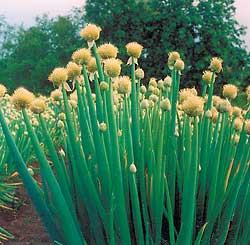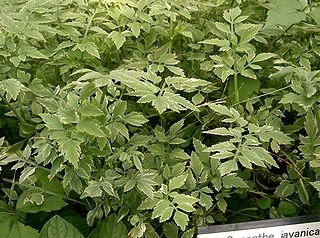
Allium fistulosum, the Welsh onion, also commonly called bunching onion, long green onion, Japanese bunching onion, and spring onion, is a species of perennial plant.

Green laver, known as aonori in Japan and parae (파래) in Korean, is a type of edible green seaweed, including species from the genera Monostroma and Enteromorpha. It is commercially cultivated in some bay areas in Japan, Korea, and Taiwan, such as Ise Bay. It is rich in minerals such as calcium, magnesium, lithium, vitamins, and amino acids such as methionine. It is also called "Aosa" (アオサ) in some places in Japan.

Gujeolpan refers to either an elaborate Korean dish consisting of nine different foods assorted on a wooden plate with nine divided sections in an octagon shape or the plate itself. The name is composed of three hanja words: gu, jeol, and pan in Korean. Foods are separated by color and ingredients, and comprise various namul, meats, mushrooms, and seafood items. In the center of the tray is a stack of small jeon made with wheat flour, which are called miljeonbyeong (밀전병). In addition to its use as a food platter used to serve many dishes of food at once, gujeolpan is also considered a decorative item.

Amaranthus tricolor, known as edible amaranth, is a species in the genus Amaranthus.

Glebionis coronaria, formerly called Chrysanthemum coronarium, is a species of flowering plant in the daisy family. It is native to the Mediterranean region. It is cultivated and naturalized in East Asia and in scattered locations in North America.

Allium monanthum, the Korean wild chive, is a spring vegetable with minuscule bulbous roots that have a mild onion flavor and found in the woodlands of Korea, Japan, northeastern Russia (Primorye), and northeastern China.

Soybean sprout is a culinary vegetable grown by sprouting soybeans. It can be grown by placing and watering the sprouted soybeans in the shade until the roots grow long. Soybean sprouts are extensively cultivated and consumed in Korea.

Banchan or bansang is a collective name for small side dishes served along with cooked rice in Korean cuisine. As the Korean language does not distinguish between singular and plural grammatically, the word is used for both one such dish or all of them combined.
The basic table setting for a meal called bansang (반상) usually consists of bap, guk or tang (soup), gochujang or ganjang, jjigae, and kimchi. According to the number of banchan added, the table setting is called 3 cheop (삼첩), 5 cheop (오첩), 7 cheop (칠첩), 9 cheop (구첩), 12 cheop (십이첩) bansang, with the 12 cheop used in Korean royal cuisine.

Osmunda japonica, also called Asian royal fern, is a fern in the genus Osmunda native to east Asia, including Japan, China, Korea, Taiwan, and the far east of Russia on Sakhalin. It is called gobi (고비) in Korean and zenmai in Japanese.

Perilla frutescens, commonly called perilla or Korean perilla, is a species of Perilla in the mint family Lamiaceae. It is an annual plant native to Southeast Asia and Indian highlands, and is traditionally grown in the Korean peninsula, Southern China, Japan and India as a crop. An edible plant, perilla is a very attractive plant for the garden and attracts butterflies. It is an aromatic plant with a strong minty smell. Various perilla varieties are traditionally used by local people, the leaves are used as a vegetable and the seeds supply nutritious cooking oil. A variety of this plant, P. frutescens var. crispa or "shiso", is widely grown and is one of the most popular garnishes in Japan, used as an antidote for fish and crab meat allergy or as a food colorant. In the United States, perilla is a weed pest, toxic to cattle after ingestion.

Namul refers to either a variety of edible grass or leaves or seasoned herbal dishes made of them. Wild greens are called san-namul, and spring vegetables are called bom-namul. On the day of Daeboreum, the first full moon of the year, Koreans eat boreum-namul with five-grain rice. It is believed that boreum namuls eaten in winter help one to withstand the heat of the summer to come.

Heotjesatbap, a traditional Korean dish, is a variety of bibimbap, served with soy sauce (ganjang) instead of the gochujang that is more commonly used. Heotjesabap consists of mainly several types of namul over white rice. It is also served with grilled fish and some jeon.

Kongbap is a Korean dish consisting of white or brown rice cooked together with one or more varieties of beans. Kongbap may be made from scratch by combining and cooking together dried rice and beans, although it is also commercially available in premixed packages in dried form in grocery stores throughout Korea, as well as in Korean grocery stores in other nations. Although the exact mixture may vary, typical ingredients include short-grain brown rice, green peas, azuki beans, black soybeans, yulmu, black glutinous rice, barley, and sorghum. Another typical mixture consists only of white rice and green peas. The dried kongbap mixture is generally soaked in water for several hours or overnight before cooking, in order to ease the softening process of the beans while cooking.

Mung bean sprouts are a culinary vegetable grown by sprouting mung beans. They can be grown by placing and watering the sprouted beans in the shade until the roots grow long. Mung bean sprouts are extensively cultivated and consumed in East Asia.

Oenanthe javanica, commonly Java waterdropwort, Chinese celery, Indian pennywort, Japanese parsley, water celery and water dropwort, is a plant of the water dropwort genus originating from East Asia.. It has a widespread native distribution in temperate Asia and tropical Asia, and is also native to Queensland, Australia.

Bap is a Korean name of cooked rice prepared by boiling rice and/or other grains, such as black rice, barley, sorghum, various millets, and beans, until the water has cooked away. Special ingredients such as vegetables, seafood, and meat can also be added to create different kinds of bap.

Mu or Korean radish is a variety of white radish with a firm crunchy texture.

Aehobak, also called Korean zucchini or Korean courgette, is an edible, green to yellow-green summer squash. Although nearly all summer squashes are varieties of Cucurbita pepo, aehobak belongs to the species Cucurbita moschata. Commonly used in Korean cuisine, an aehobak has the shape of zucchini, but with thinner, smoother skin, and more delicate flesh. It is usually sold in shrink-wrapped plastic.

Ligularia fischeri, known as gomchwi or Fischers ragwort, is a species in the genus Ligularia.

Bomdong (봄동) is a hardy early spring cabbage with tougher, sweeter leaves. The leaves of bomdong, unlike those of regular napa cabbages, fall to the sides, giving the plant a flat shape.




















